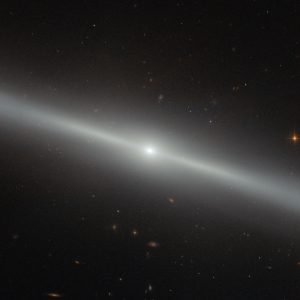NGC 4762: Una Scia Luminosa in Cielo
Questa straordinaria immagine del telescopio Hubble immortala una sorprendente galassia visibile di taglio, NGC 4762, tanto che appare simile ad una scia luminosa che percorre un silenzioso cammino nelle profondità del cosmo.
NGC 4762 si trova a circa 58 milioni di anni luce di distanza nella costellazione della Vergine ed è parte dell’Ammasso della Vergine.
Ritenuta in precedenza una galassia a spirale barrata, NGC 4762 è invece una galassia lenticolare, un tipo intermedio tra le ellittiche e le spirali. La visione di taglio rende difficile determinare la sua reale forma, ma gli astronomi hanno scoperto che la galassia consiste di quattro componenti principali, un bulge centrale, una barra, un disco sottile e un anello esterno.
Il disco è asimmetrico e distorto, un’anomalia che potrebbe essere spiegata dal fatto che NGC 4762 abbia cannibalizzato in un tempo lontano una galassia più piccola, i cui resti potrebbero trovarsi nel disco, alterandone la morfologia.
Nonostante il suo aspetto sereno ed elegante, la splendida NGC 4762 contiene un nucleo galattico attivo, una regione centrale altamente energetica.
[ Barbara Bubbi ]
http://spacetelescope.org/images/potw1443a/
Credit: ESA/Hubble & NASA

Lascia un commento